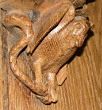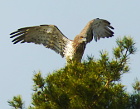More historical data about Short-toed Eagles in Switzerland can be found on a webpage of the journal Ornithologische Beobachter:
• Karl Daut, 1910 – Seltenere Vertreter der schweizerischen Avifauna. Der Schlangenadler – Circaetus gallicus (Gm.) [A rare representative of the Swiss avifauna. Short-toed Eagle] // Der Ornithologische Beobachter, VIII (1): pp. 1-3. –  (De).
(De).
The former and present state of the species in the Canton of Valais /map/ is described in the communication, published this year:
• Lionel Maumary, 2015 – Nouvelle nidification du Circaète Jean-le-Blanc en Valais [New nesting of Short-toed Eagle in Valais] // Oiseaux.ch (Fr).
 The following web resource deserves to be mentioned again: the map of the sighting locations is available for the registered contributors of Ornitho.ch only. However, any visitor of the site can view the photo gallery. The most of the pictures of Short-toed Eagles represented there have been taken in Switzerland.
The following web resource deserves to be mentioned again: the map of the sighting locations is available for the registered contributors of Ornitho.ch only. However, any visitor of the site can view the photo gallery. The most of the pictures of Short-toed Eagles represented there have been taken in Switzerland.






